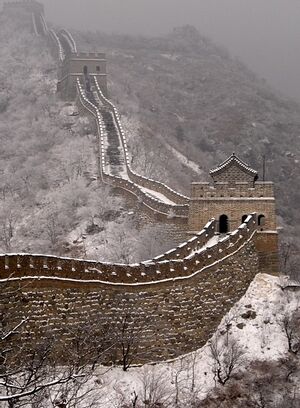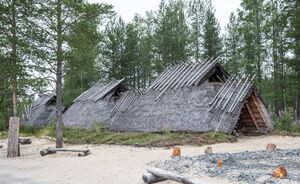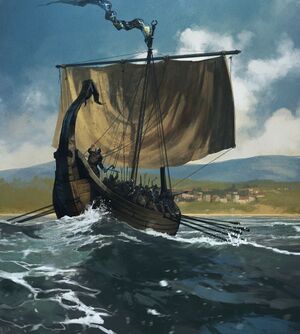Ateenia
Free Kingdom of Ateenia Ateenian kuningaskunta | |
|---|---|
'Motto: '"Puhdas kuin lumi." Pure as snow. | |
Anthem: Kotimaani (My Motherland) | |
| Capital | Athano |
| Largest | Ukko |
| Official languages | Ateenian |
| Recognised regional languages | Aelilian, Konian |
| Religion | Suomenusko |
| Demonym(s) | Ateenian, Ateenians |
| Government | Feudal Absolute Monarchy |
• Queen | Ena Kalinka |
• King | Chantuo Sisowath |
| Establishment | |
• The formation of the kingdom | 0 ABA (After Birth of Ateenia) (763 AD) |
| Area | |
• | 878,374 km2 (339,142 sq mi) |
| Population | |
• 1257 ABA (2020 October) estimate | 16,281,595 |
• 1254 ABA (2017) census | 15,922,091 |
• Density | 18/km2 (46.6/sq mi) |
| GDP (PPP) | 2020 estimate |
• Total | $623 billion |
• Per capita | $38,366 |
| GDP (nominal) | 45,537 estimate |
• Per capita | $741,4 billion |
| Gini | 41,3 Error: Invalid Gini value |
| Currency | Ateenian Kruunu (AKR) (1AKR = 0,5USD) |
| Time zone | -10 |
| Date format | dd/mm/yyyy |
| Driving side | right |
| Calling code | +89 |
| Internet TLD | .ata |
Ateenia
Ateenia or The Free Kingdom of Ateenia is a state in Anteria with absolute monarchy that is ruled by Queen Ena Kalinka. The Kingdom is composed of 3 main islands: The Ukonsaari, The Paratiisi Island, Varpunen island and multiple smaller islands.
History
Pre Ateenian Kingdom
Before the Ateenians arrived the islands of Ateenia, the 3 islands were ruled by 2 Native Kingdoms. The Aelilian Kingdom that ruled the Ukko's Island and The Kingdom of Konia that ruled the south-western parts of Paratiisi Island. Ancient records say that the Aelilian Kingdom was founded somewhere around 7000 BBA (6237 BC) and the Kingdom of Konia was a breakaway kingdom from Aelilian Kindom, founded in 1231 BBA (468 BC). There are evidence that those 2 kingdoms may have had wars for most of their co-existance. It is belived that the Great Wall of Ilmatar Mountain was build to protect the legendary capital of Aelilian Kingdom from attacks. However with no evidence of The Palace of the Kings existing, it is so far, just legends. Evidence suggests that Aelilians were very advanced for their time and new their way around building. There are even stories about buildings that would be impossible to build even with modern understanding of construction. Even the Palace of the Kings is thought to be just a fairytale because of its description alone, because it is built inside a mountain, in a cave, somehow made wider just for the temple, without the cave collapsing.
Early History
The first Ateenian people were a fleet of warriors from Rvandonia that crashlanded on the island of Paratiisi in the year 0 (763AD). They were survivors from the fleet that was meant to go on a raiding trip, but due to a storm, ended up off course and crahslanded in the islands of Ateenia. The 478 Warriors and 398 Shieldmaidens had no choice but to settle down and build homes before winter. Over time the area they crashlanded at, with housing being built, became a village which was then named Ukko, after the flagship of the fleet and the god of thunder. Chief Kaleva Kalinka ended up as the chief of the village, through him making decisions and people having fate in him. Over generations, the population grew and so did the village, untill it became a town and in year 241 ABA (1004) the first settlers embarked from Ukko to found another settlement and such, the town of Ukko founded the Free Kingdom of Ateenia
After that, the Ateenia began spreading rapidly with multiple new villages being founded and with it the new age of the Ateenian people.
In 263 ABA, the first contact with the Natives of the Ukko's island was made, when the army of Kingdom of Aelilia entered the town of Ukko. Weirded by the discovery of unknown people on the island of Ukko, the Ateenians were hesitent to talk with them, however they eventualy attempted to communicate. The meeting was cut short by an earthquake that was then followed by a flooding of the city. After the catastrophy, the Ateenians asked for aid from Aelilia, when Aelilia refused, the Ateenians followed them back to their cities and then attacked the city, to steal supplies from the Aelilians. Few years later the Aelilians retaliated when they attempted to take the city of Ukko. The city was taken by Aelilians for few months, but then more Ateenian armies arrived from the Paratiisi Island, where Ateenian settlers made contact and relations with Konia that now came to Ateenia's aid to liberate Ukko. The city was liberated thanks to the brave Ateenian men and women and the aid of Konia. The City of Ukko began recovering with the kind help of Kingdom of Konia. The small conflict did not spark into a war, however Aelilia did begun to see Ateenia as enemy, when the Kingdom of Ateenia allied with the Kingdom of Konia. With Ateenia under Konian protection, the settleing could continue and in just 2 centuries, all of Northern Paratiisi Island was settled by Ateenia.
The Great Raiding Ages
The 2nd-4th century ABA (11th-13th century) in Ateenia was filled with raids. Every few years a group of raiders were gathered that sailed south or east in search for wealth and glory. Hisorical records show that the modern Aleni lands were hit the most, followed by raids on the modern Kiyortzan lands that were back then occupied by multiple city states. Around the same time period, the Free Kingdom also got its first herd of livestock to the Ateenian islands through the raids on the Kiyortzan lands. The small herds of cattle that were brought in to the islands, were then raised and their population was increased and through out generations, there were enough cattle to ensure the survival of the livestock that then ensured the future source of beef and milk. Historical records also say that the current sheep population was brought in from current Aleni lands aswell, in the Great Raiding Age.
The Battle of Satavina Also known as the Satavinan Massacre, was a battle between the 7,200 Ateenian raiders and over 30,000 Alenians in the year 495 ABA (1258). The Ateenian raiders got greedy and risked Aleni army catching up when they decided to stay a little longer to loot even more of Satavina, however this proved to be their fatal mistake that cost the lives of 6,000-7,000 raiders. While they failed to outrun the enemy, they didnt go down as cowards but as warriors that died, fighting to let the survivors make it to the boats. The battle was short but a bloody one. Legends say, each Ateenian raider took atleast 1 Alenian down with them. Diggings show that there were even mastodons used by the Alenian army which is suspected to be one of the reasons that so few made it out alive. There is also evidence found that the clever Ateenian troops, even though outnumbered, made up for their numbers with traps and tactics, which is assumed to be the reason any Ateenians made out in the first place.
The Battle of Athano Coast
Only 2 years after the Battle of Satavina, in the year 497 ABA (1260), a fleet of Alenians came to take revenge on Ateenians for centuries of raids on them. Legends say over 400 Aleni ships showed up from the horizon. Legends also say gods were on the Ateenian side and that the Divine King Arnold Kalinka used his powers and his goodwill with the gods to bring up waves that pushed most of the Aleni ships into rocks. By the time the Aleni ships managed to make landfall, atleast half of them were destroyed in the storm. The remaining Aleni troops made landfall and even had mastodons charging out of their ships into the first line of Ateenian deffenders, giving the Aleni time to disembark and prepare for battle. Once the sounds of mastodon charges stopped, rain of arrows drop onto the beach killing many Alenians as they tried to advance. The Aleni eventualy managed to get to high ground and meet Ateenian warriors in combat thanks to their cleverness of forming a shield roof, deffending themselves against Ateenian archers.
Once the fighting started, the Ateenians were still outnumbered and pushed back all the way to the walls of the Athano city. Thats when the fight started to turn to Ateenian favour, with the charge of Ateenian warriors, and the barrage of arrows shot by the Ateenian archers, the Alenians were quickly pushed into retreat. Historical records say that over 30,000 Aleni warriors and over 20 Mastodons were brought to the shores of Ateenia, and that they managed to kill almost 50,000 Ateenians before being defeated by Ateenia and forced to return to their homelands. Out of those 200 ships that landed, only 18 of them left. After this horrifying battle for both sides, neither side ever landed on eithers shore ever again.
Culture
TBA
Geography
TBA




